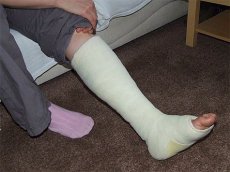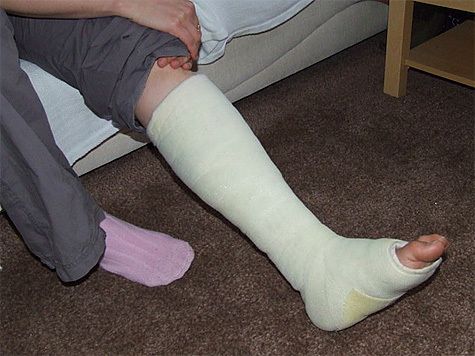Medical expert of the article
New publications
Leg fracture
Last reviewed: 04.07.2025

All iLive content is medically reviewed or fact checked to ensure as much factual accuracy as possible.
We have strict sourcing guidelines and only link to reputable media sites, academic research institutions and, whenever possible, medically peer reviewed studies. Note that the numbers in parentheses ([1], [2], etc.) are clickable links to these studies.
If you feel that any of our content is inaccurate, out-of-date, or otherwise questionable, please select it and press Ctrl + Enter.

What to do if you broke your leg and there is no doctor nearby? Before the ambulance arrives, you need to take the necessary measures so that your leg heals properly and to avoid negative health consequences.
Diagnosis and examination of fracture
First of all, it is a doctor's survey. The more information the doctor knows about the fracture, the more accurately he can prescribe treatment
In case of fractures, X-rays are always used to see an accurate picture of the bone damage.
Additional blood and urine tests are ordered for fractures to avoid infection.
Additional examination methods are prescribed when a person does not tolerate fracture treatment well.
Home remedies for broken legs

- You need to lie down and not injure the sore leg, it should be at rest
- You need to put an ice pack on the injury site, but do not keep it on for longer than 15 minutes. Then take a break for 5-10 minutes and apply ice again. Do this until you get to the ambulance, this will reduce the pain at the fracture site. To prevent the ice from burning your skin too much, wrap it in a cloth, such as a towel.
- If the ambulance takes a long time to arrive, know that you will still have to undergo surgery. Therefore, do not drink anything except water and do not eat until the doctors arrive.
Treatment for fractures
It depends on what kind of fracture you have and how serious it is. If the bones at the fracture site are displaced, then the patient is first given painkillers and then other measures are taken to treat the leg. This method is called repositioning.
First aid for fractures
To provide first aid for fractures, you must first apply a splint to the fracture. And then, after providing emergency care, the patient can be sent to an orthopedic doctor. If the tibia or femur is broken, an orthopedic surgeon is definitely needed as a consultant.
What needs to be done after applying a splint to hold broken bones together.
- Bone screws
- Bone rods
- Metal plates
- Take painkillers - in tablets or injections.
 [ 6 ]
[ 6 ]
How long does it take for a fracture to heal?
Typically, it takes six to eight weeks for a fracture to heal. During this time, the bone tissue will heal if it is not overloaded.
If a person is elderly, bones take longer to heal, since bone tissue has already lost its former elasticity. Hip and ankle fractures are especially dangerous - such injuries heal more slowly and are more painful.
If the fracture is open, the bone may heal much more slowly than if the fracture is closed because the open wound can become infected.
With an open fracture, the risk of bone infection increases, which can significantly delay the healing process.
When to consult a doctor
Some types of fractures look like an injury or a sprain, and then a person does not go to the doctor. But it is necessary to do so, because there may be severe pain and the bones may not heal properly. When is a doctor's consultation necessary?
- If you have a bone protruding from under your skin
- If the bone is visible under the skin but does not break it
- If the pain is so severe that you cannot step on your foot
- If the leg is swollen, every touch causes pain, and there is blueness at the site of injury
When to return to hospital after fracture treatment
If a person has already had the plaster removed after the bones have healed, but the person still feels unwell, they should see a doctor again. This is a condition that requires caution.
The muscles of the broken limb are insensitive (most likely, swelling prevents the blood flow from spreading through the leg)
The leg has changed color to blue or red, the person has chills, swelling of the affected limb, pain. This condition may be symptoms of an infection of the limb.
Prevention of fractures
- Take calcium supplements that strengthen your bones, making them less brittle
- Do special exercises to improve the elasticity of your limbs and skeletal bones
- Use protective equipment in vehicles, especially seat belts in cars and helmets in motorcycles.
- Avoid overexertion during exercise

